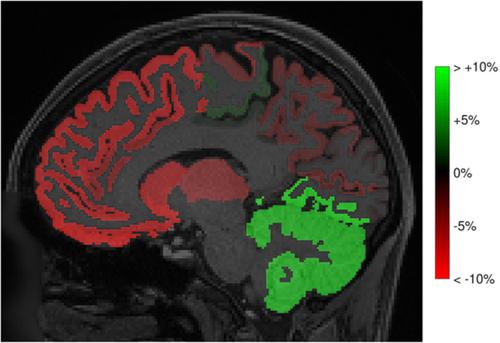当前位置:
X-MOL 学术
›
Hum. Brain Mapp.
›
论文详情
Our official English website, www.x-mol.net, welcomes your
feedback! (Note: you will need to create a separate account there.)
Constrained spherical deconvolution of nonspherically sampled diffusion MRI data
Human Brain Mapping ( IF 3.5 ) Pub Date : 2020-11-10 , DOI: 10.1002/hbm.25241 Jan Morez 1 , Jan Sijbers 1 , Floris Vanhevel 2 , Ben Jeurissen 1
Human Brain Mapping ( IF 3.5 ) Pub Date : 2020-11-10 , DOI: 10.1002/hbm.25241 Jan Morez 1 , Jan Sijbers 1 , Floris Vanhevel 2 , Ben Jeurissen 1
Affiliation

|
Constrained spherical deconvolution (CSD) of diffusion‐weighted MRI (DW‐MRI) is a popular analysis method that extracts the full white matter (WM) fiber orientation density function (fODF) in the living human brain, noninvasively. It assumes that the DW‐MRI signal on the sphere can be represented as the spherical convolution of a single‐fiber response function (RF) and the fODF, and recovers the fODF through the inverse operation. CSD approaches typically require that the DW‐MRI data is sampled shell‐wise, and estimate the RF in a purely spherical manner using spherical basis functions, such as spherical harmonics (SH), disregarding any radial dependencies. This precludes analysis of data acquired with nonspherical sampling schemes, for example, Cartesian sampling. Additionally, nonspherical sampling can also arise due to technical issues, for example, gradient nonlinearities, resulting in a spatially dependent bias of the apparent tissue densities and connectivity information. Here, we adopt a compact model for the RFs that also describes their radial dependency. We demonstrate that the proposed model can accurately predict the tissue response for a wide range of b‐values. On shell‐wise data, our approach provides fODFs and tissue densities indistinguishable from those estimated using SH. On Cartesian data, fODF estimates and apparent tissue densities are on par with those obtained from shell‐wise data, significantly broadening the range of data sets that can be analyzed using CSD. In addition, gradient nonlinearities can be accounted for using the proposed model, resulting in much more accurate apparent tissue densities and connectivity metrics.
中文翻译:

非球形采样扩散 MRI 数据的约束球形反卷积
扩散加权 MRI (DW-MRI) 的约束球面反卷积 (CSD) 是一种流行的分析方法,可无创地提取活的人脑中的全白质 (WM) 纤维取向密度函数 (fODF)。它假设球面上的 DW-MRI 信号可以表示为单纤维响应函数(RF)和 fODF 的球面卷积,并通过逆运算恢复 fODF。CSD 方法通常要求对 DW-MRI 数据进行壳层采样,并使用球面基函数(例如球面谐波 (SH))以纯球面方式估计 RF,而忽略任何径向依赖性。这排除了使用非球形采样方案(例如笛卡尔采样)获取的数据的分析。此外,由于技术问题,也可能出现非球形采样,例如,梯度非线性,导致表观组织密度和连接信息的空间依赖偏差。在这里,我们为 RF 采用了一个紧凑模型,该模型也描述了它们的径向依赖性。我们证明了所提出的模型可以准确预测各种 b 值的组织反应。在壳数据上,我们的方法提供的 fODF 和组织密度与使用 SH 估计的没有区别。在笛卡尔数据上,fODF 估计值和表观组织密度与从壳数据中获得的值相当,显着拓宽了可以使用 CSD 分析的数据集范围。此外,可以使用所提出的模型来解释梯度非线性,从而产生更准确的表观组织密度和连通性指标。导致表观组织密度和连接信息的空间依赖偏差。在这里,我们为 RF 采用了一个紧凑模型,该模型也描述了它们的径向依赖性。我们证明了所提出的模型可以准确预测各种 b 值的组织反应。在壳数据上,我们的方法提供的 fODF 和组织密度与使用 SH 估计的没有区别。在笛卡尔数据上,fODF 估计值和表观组织密度与从壳数据中获得的值相当,显着拓宽了可以使用 CSD 分析的数据集范围。此外,可以使用所提出的模型来解释梯度非线性,从而产生更准确的表观组织密度和连通性指标。导致表观组织密度和连接信息的空间依赖偏差。在这里,我们为 RF 采用了一个紧凑模型,该模型也描述了它们的径向依赖性。我们证明了所提出的模型可以准确预测各种 b 值的组织反应。在壳数据上,我们的方法提供的 fODF 和组织密度与使用 SH 估计的没有区别。在笛卡尔数据上,fODF 估计值和表观组织密度与从壳数据中获得的值相当,显着拓宽了可以使用 CSD 分析的数据集范围。此外,可以使用所提出的模型来解释梯度非线性,从而产生更准确的表观组织密度和连通性指标。
更新日期:2021-01-02
中文翻译:

非球形采样扩散 MRI 数据的约束球形反卷积
扩散加权 MRI (DW-MRI) 的约束球面反卷积 (CSD) 是一种流行的分析方法,可无创地提取活的人脑中的全白质 (WM) 纤维取向密度函数 (fODF)。它假设球面上的 DW-MRI 信号可以表示为单纤维响应函数(RF)和 fODF 的球面卷积,并通过逆运算恢复 fODF。CSD 方法通常要求对 DW-MRI 数据进行壳层采样,并使用球面基函数(例如球面谐波 (SH))以纯球面方式估计 RF,而忽略任何径向依赖性。这排除了使用非球形采样方案(例如笛卡尔采样)获取的数据的分析。此外,由于技术问题,也可能出现非球形采样,例如,梯度非线性,导致表观组织密度和连接信息的空间依赖偏差。在这里,我们为 RF 采用了一个紧凑模型,该模型也描述了它们的径向依赖性。我们证明了所提出的模型可以准确预测各种 b 值的组织反应。在壳数据上,我们的方法提供的 fODF 和组织密度与使用 SH 估计的没有区别。在笛卡尔数据上,fODF 估计值和表观组织密度与从壳数据中获得的值相当,显着拓宽了可以使用 CSD 分析的数据集范围。此外,可以使用所提出的模型来解释梯度非线性,从而产生更准确的表观组织密度和连通性指标。导致表观组织密度和连接信息的空间依赖偏差。在这里,我们为 RF 采用了一个紧凑模型,该模型也描述了它们的径向依赖性。我们证明了所提出的模型可以准确预测各种 b 值的组织反应。在壳数据上,我们的方法提供的 fODF 和组织密度与使用 SH 估计的没有区别。在笛卡尔数据上,fODF 估计值和表观组织密度与从壳数据中获得的值相当,显着拓宽了可以使用 CSD 分析的数据集范围。此外,可以使用所提出的模型来解释梯度非线性,从而产生更准确的表观组织密度和连通性指标。导致表观组织密度和连接信息的空间依赖偏差。在这里,我们为 RF 采用了一个紧凑模型,该模型也描述了它们的径向依赖性。我们证明了所提出的模型可以准确预测各种 b 值的组织反应。在壳数据上,我们的方法提供的 fODF 和组织密度与使用 SH 估计的没有区别。在笛卡尔数据上,fODF 估计值和表观组织密度与从壳数据中获得的值相当,显着拓宽了可以使用 CSD 分析的数据集范围。此外,可以使用所提出的模型来解释梯度非线性,从而产生更准确的表观组织密度和连通性指标。











































 京公网安备 11010802027423号
京公网安备 11010802027423号